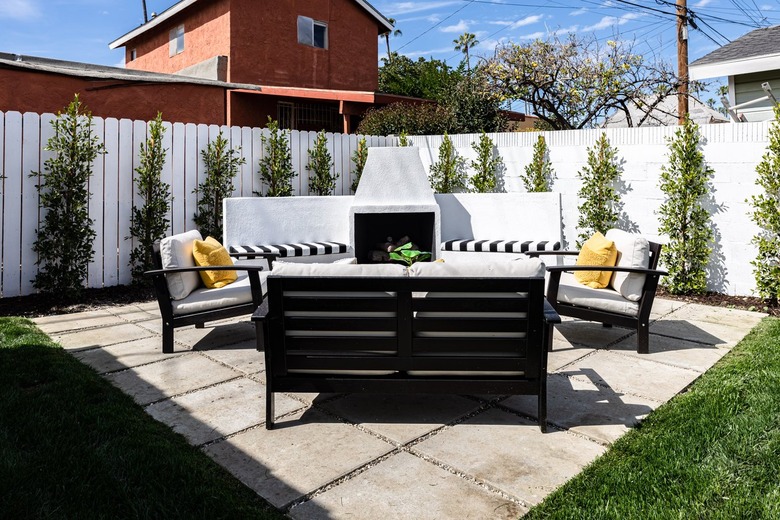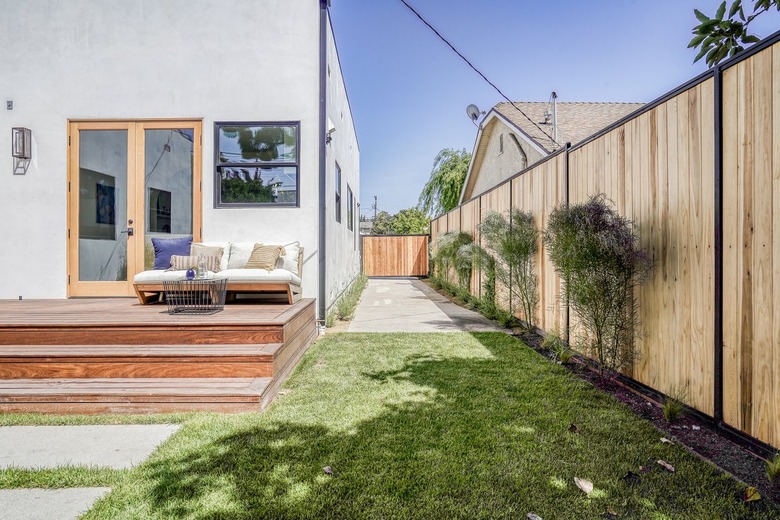How Much Does Fence Installation Cost?
We may receive a commission on purchases made from links.
Not surprisingly, fence installation costs are highly variable and depend to a great extent on the fencing materials you choose, which in turn depend on the purpose of the fence. You may want a privacy fence to protect your family from prying eyes, in which case you're probably looking at a relatively expensive opaque material, like wood. On the other hand, you may simply be interested in keeping animals inside the yard or excluding them, and wire, chain link, or vinyl pickets — which cost much less — would do the job. If you're looking to adorn your well-manicured lawn with a decorative picket fence, the average cost will be somewhere in between.
Looking to install a fence and want to know how much to budget? Here's what you need to know about fence installation cost — and what kind of labor goes into the job.
Tip
The national average cost for fence installation is around $4,600, but it varies with fence material, fence styles, length, and a number of other factors.
Fencing Materials Costs per Linear Foot
Fencing Materials Costs per Linear Foot
Rather than quoting a cost for a complete fence, installers often quote by units, such as post or panel. For example, composite fence installations are often quoted by the number of posts, whereas panel fences are quoted by the number of fence panels. When it doesn't make sense to quote in this way or you're looking for a generic pricing scheme that applies to any type of material, the standard unit for fence installation is the linear foot. Linear foot estimates often include labor as well as material costs, and when that's the case, you can get a good idea of the materials cost for a DIY fence project by halving the estimate.
- Wire fence: At the low end of the cost scale, wire fences are typically installed to control livestock, keep animals out, or demarcate rural property lines. Posts can be made of rough-sawn lumber or pressure-treated fir or pine, and the wire can be smooth or barbed. The cost range for a wire fence is between $1 and $4 per linear foot, and it may be slightly higher if the wire is electrified since that requires extra equipment.
- Chain-link fence: Chain-link fencing comes as a system complete with posts, fencing, and connectors, so some fencing companies might quote installation on a per-post basis, but the usual method is to quote by linear foot. The quote will be based on fence height. A 4-foot fence costs between $45 and $119, a 5-foot one costs between $66 and $125, and a 6-foot one costs between $85 and $139 per linear foot.
- Wood fence: Wood is the material of choice for many homeowners. It doesn't last as long as some other materials, but its naturalistic appearance suits almost every situation, and it can be fashioned into almost any type of fence. The two most suitable wood species for fencing are redwood and Western red cedar, and although redwood is slightly more expensive, their cost is comparable. Prices range from $1.50 to $10 per picket, from $31 to $195 per panel, or anywhere from $14 to $31 per linear foot. Pressure-treated pine and prefinished whitewood are two less expensive options, costing from $1 to $5 per picket and from $26 to $80 per panel.
- Vinyl fence: Vinyl is manufactured to look like wood, and it lasts longer, which could be one reason it's slightly more expensive. Both vinyl picket and panels are available, and all the rails and sometimes even the posts are made of vinyl, although purely vinyl posts are usually reserved for installation on a flat surface, such as a deck. When posts are sunken into the ground, they are usually vinyl-coated, pressure-treated wood, or they consist of vinyl sleeves applied over pressure-treated posts. The cost of a vinyl fencing installation is $17 to $38 per linear foot.
- Composite fence: Composites can be manufactured to look like wood or stone, and composite fencing is often quoted per post, typically within a range of $56 to $66 per post. When quoted in linear feet, the cost is typically between $26 and $57 per linear foot.
- Metal fence: The two metals used most often for fencing are aluminum and steel, and different metal gauges are available. The fencing is usually delivered in parts complete with connectors and is assembled on-site. The cost for a standard-gauge metal fence is between $83 and $116 and for a heavy-gauge one, it's between $108 and $180 per linear foot.
- Wrought-iron fence: One of the longest-lasting and most stylish fencing materials, wrought iron is generally considered a high-end material. Much of the wrought iron available at building centers and online is steel or aluminum painted black. Real wrought iron is often custom made or salvaged from an existing fence, but some retailers do stock it, with pricing between $250 and $1,000 per 5 x 8-foot panel.
Standard fence height is typically between 4 and 6 feet. If you want to build one higher than that, the cost will also be higher, but by the same token, if you build a shorter one, the cost will be lower. Decorative picket fences are often only 3 feet high, and the savings in wood makes them much less expensive to build than standard-height fences.
Additional Fence Installation Cost Factors
Additional Fence Installation Cost Factors
When building a new fence, the bulk of the budget will go toward purchasing the fencing materials and paying for labor (assuming you don't DIY the project). There are other potential costs for which homeowners should be prepared, however, depending on the situation:
- Fence removal: If you're replacing an existing fence with a new one, you'll have to include removal of the old fence in your final cost. Professional fence removal typically costs between $3 and $5 per linear foot. On the other hand, you may be able to salvage part of an existing fence and simply tack new fencing onto it, which is a bonus that will probably save you money.
- Sloping ground: It's far easier to build a fence on flat ground than on ground that forms hills and valleys. You probably won't need more materials if you're building a fence on sloping ground, but the labor costs will be higher, especially if extra work is needed to incorporate the fence into the landscaping. It may make sense to hire a landscaper to level the ground to make fence installation easier, and that also adds to the cost of the project.
- Gates: Most fence estimates include a single gate. If your design calls for more than one or you need an extra-wide gate for a vehicle, you'll incur extra materials and labor costs. A walk-through gate typically costs from $150 to $250, and a drive-through gate can cost as much as $850 including labor.
- Permits: Many communities require a building permit to erect a fence, and the fence must conform to local building codes and HOA guidelines. If you're working with a fence contractor, securing the permit is part of the contractor's job, but whether the contractor gets the permit or you do, it could add from $60 to as much as $800 to the project cost.
Wood Privacy Fence Cost Control
Wood Privacy Fence Cost Control
Many privacy fencing materials are supplied in modular units that are assembled on-site, and the cost of the fencing varies with the design of the modules. That's also true for many wood fences, but as a raw material, wood can also be fashioned into a number of free-form designs. When you're designing your own fence, keeping it simple is the best way to cut costs because the simpler the type of fence you erect, the less the labor and materials costs.
A wood privacy fence with a shadowbox design not only calls for more wood than a picket fence but needs sturdier support. That drives up costs because it means digging post holes deeper, which could mean renting an auger if the ground is rocky or hard whether you do the work yourself or hire a fence contractor. When wood privacy fence costs start to spiral out of control, there are some creative ways to control them, including:
- Choosing a less expensive type of wood, perhaps substituting painted pressure-treated pine for redwood or cedar. You can also opt for panels, which are generally less expensive and less labor intensive than slats. You can purchase a preconstructed 6 x 8-foot redwood panel from Home Depot for less than it costs to buy the individual components and construct it yourself.
- Making the fence shorter and installing lattice on top. Top-quality fence top wood lattice costs from $8 to $20 per linear foot, but if you don't mind standard-grade material, you can get it for $2 to $4.50 per linear foot. If you make the fence out of vinyl, the average price of vinyl lattice is even lower at $1.50 to $3.50 per linear foot.
- Erecting a relatively inexpensive picket fence and attaching a privacy screen to the pickets.
- Constructing all or part of your fence from wood pallets. Besides being free, pallets are already assembled into panels, so all you have to do is erect the posts to support them. Choose pallets with the International Plant Protection Convention logo, which means they've been fumigated against pests and plant diseases. They won't look as sophisticated as real fencing panels, but they're free.
- Building (or rather, planting) a living fence using dense, low-growing shrubbery. Some popular choices include privet or boxwood ($3 per linear foot), yew ($5 to $6 per linear foot), and spotted laurel ($8 to $9 per linear foot).

